
EBK CHEMISTRY: THE MOLECULAR NATURE OF
7th Edition
ISBN: 9781119513216
Author: HYSLOP
Publisher: JOHN WILEY+SONS INC.
expand_more
expand_more
format_list_bulleted
Concept explainers
Textbook Question
Chapter 11, Problem 19PE
Chromium crystallizes in a body-centered cubic structure. How many chromium atoms are in its unit cell? (Hint: Use Figure 11.39 as a guide.)
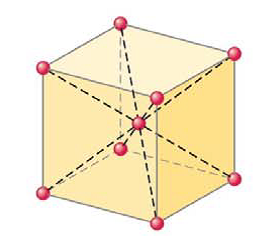
Figure 11.39 A body-centered cubic unit cell. Lattice points are located at each of the eight corners and in the center of the unit cell.
Expert Solution & Answer
Want to see the full answer?
Check out a sample textbook solution
Students have asked these similar questions
A chemical engineer is studying the two reactions shown in the table below.
In each case, she fills a reaction vessel with some mixture of the reactants and products at a constant temperature of 70.0 °C and constant total pressure.
Then, she measures the reaction enthalpy AH and reaction entropy AS of the first reaction, and the reaction enthalpy AH and reaction free energy AG of the
second reaction. The results of her measurements are shown in the table.
Complete the table. That is, calculate AG for the first reaction and AS for the second. (Round your answer to zero decimal places.) Then, decide whether, under
the conditions the engineer has set up, the reaction is spontaneous, the reverse reaction is spontaneous, or neither forward nor reverse reaction is spontaneous
because the system is at equilibrium.
-
P₁ (s) + 20HF (g). 4PF, (g) + 10H2(g)
AH-1005. kJ
J
AS 2929.
K
AG =
0 kJ
Which is spontaneous?
this reaction
the reverse reaction
neither
AH = 12. kJ
+0=
AS =
SnO2 (s) + 2CO(g) →…
A chemist fills a reaction vessel with 0.281 g silver chromate (Ag₂CrO4) solid, 0.710 M silver (Ag*) aqueous solution, and 0.985 M chromate (CrO2-)
aqueous solution at a temperature of 25.0°C.
Under these conditions, calculate the reaction free energy AG for the following chemical reaction:
Ag2CrO4(s) 2Ag(aq) + CrO4(aq)
Use the thermodynamic information in the ALEKS Data tab. Round your answer to the nearest kilojoule.
4
☐ kJ
x
Draw the structure corresponding to each IUPAC name.
Part 1 of 2
A skeletal structure corresponding to the IUPAC name 3-ethylhexane.
Click and drag to start drawing a
structure.
Chapter 11 Solutions
EBK CHEMISTRY: THE MOLECULAR NATURE OF
Ch. 11 - Prob. 1PECh. 11 - List the following in order of their boiling...Ch. 11 - Propylamine and trimethylamine have the same...Ch. 11 - People living in arid, dry, regions can cool their...Ch. 11 - Use the kinetic molecular theory to explain why...Ch. 11 - Considering Figure 11.24, in which direction...Ch. 11 - Suppose a liquid is in equilibrium with its vapor...Ch. 11 - The Dead Sea is approximately 1300 ft below sea...Ch. 11 - The atmospheric pressure at the summit of Mt....Ch. 11 - Benzene has a boiling point of 80.1C, and a...
Ch. 11 - Steam can cause more severe bums than water, even...Ch. 11 - The equilibrium line from point B to D in Figure...Ch. 11 - What phase changes will occur if water at 20C and...Ch. 11 - Prob. 14PECh. 11 - Use Le Chtelier's principle to predict how a...Ch. 11 - Prob. 16PECh. 11 - At 0.00C, hexane, C6H14, has a vapor pressure of...Ch. 11 - Prob. 18PECh. 11 - Chromium crystallizes in a body-centered cubic...Ch. 11 - What is the ratio of the ions in the unit cell of...Ch. 11 - Polonium is the only metal known to crystallize in...Ch. 11 - Use the data in the previous Practice Exercise to...Ch. 11 - Stearic acid is an organic acid that has a chain...Ch. 11 - Boron nitride, which has the empirical formula BN,...Ch. 11 - Crystals of elemental sulfur are easily crushed...Ch. 11 - 11.1 Why are the intermolecular attractive forces...Ch. 11 - Compare the behavior of gases, liquids, and solids...Ch. 11 - Prob. 3RQCh. 11 - Why do intermolecular attractions weaken as the...Ch. 11 - Prob. 5RQCh. 11 - Define polarizability. How does this property...Ch. 11 - Prob. 7RQCh. 11 - 11.8 Which nonmetals, besides hydrogen, are...Ch. 11 - Prob. 9RQCh. 11 - Which would give a stronger iondipole interaction...Ch. 11 - Prob. 11RQCh. 11 - Prob. 12RQCh. 11 - Intermolecular Forces and Physical...Ch. 11 - Prob. 14RQCh. 11 - Intermolecular Forces and Physical Properties Name...Ch. 11 - Prob. 16RQCh. 11 - Prob. 17RQCh. 11 - Prob. 18RQCh. 11 - Prob. 19RQCh. 11 - Prob. 20RQCh. 11 - Intermolecular Forces and Physical...Ch. 11 - Prob. 22RQCh. 11 - Prob. 23RQCh. 11 - Prob. 24RQCh. 11 - Prob. 25RQCh. 11 - Prob. 26RQCh. 11 - Prob. 27RQCh. 11 - Prob. 28RQCh. 11 - Prob. 29RQCh. 11 - Changes of State and Dynamic Equilibrium What...Ch. 11 - Prob. 31RQCh. 11 - Changes of State and Dynamic Equilibrium
11.32 Why...Ch. 11 - Changes of State and Dynamic Equilibrium
11.33...Ch. 11 - Changes of State and Dynamic Equilibrium
11.34....Ch. 11 - Prob. 35RQCh. 11 - Prob. 36RQCh. 11 - Vapor Pressures of Liquids and Solids
11.37...Ch. 11 - Prob. 38RQCh. 11 - Vapor Pressures of Liquids and Solids 11.39 What...Ch. 11 - Vapor Pressures of Liquids and Solids Why does...Ch. 11 - Vapor Pressures of Liquids and Solids Why do we...Ch. 11 - Prob. 42RQCh. 11 - Boiling Points of Liquids Why does the boiling...Ch. 11 - Boiling Points of Liquids Mt. Kilimanjaro in...Ch. 11 - Boiling Points of Liquids
11.45. When liquid...Ch. 11 - Prob. 46RQCh. 11 - Boiling Points of Liquids Butane, C4H10, has a...Ch. 11 - Boiling Points of Liquids
11.48. Why does have a...Ch. 11 - Boiling Points of Liquids An HF bond is more polar...Ch. 11 - Energy and Changes of State The following is a...Ch. 11 - Energy and Changes of State
11.51 Why is larger...Ch. 11 - Energy and Changes of State Would the heat of...Ch. 11 - Energy and Changes of State Hurricanes can travel...Ch. 11 - Energy and Changes of State Ethanol (grain...Ch. 11 - Energy and Changes of State A burn caused by steam...Ch. 11 - Energy and Changes of State
11.56 Arrange the...Ch. 11 - Prob. 57RQCh. 11 - Phase Diagrams
11.58 Define critical temperature...Ch. 11 - Phase Diagrams What is a supercritical fluid? Why...Ch. 11 - Phase Diagrams
11.60 What phases of a substance...Ch. 11 - Prob. 61RQCh. 11 - Prob. 62RQCh. 11 - Phase Diagrams Sketch a generic phase diagram that...Ch. 11 - Phase Diagrams
11.64 What is the significance of...Ch. 11 - Prob. 65RQCh. 11 - Le Chtelier's Principle and Changes of State State...Ch. 11 - Le Châtelier's Principle and Changes of...Ch. 11 - Le Chtelier's Principle and Changes of State Use...Ch. 11 - Le Chtelier's Principle and Changes of State Use...Ch. 11 - Le Châtelier's Principle and Changes of...Ch. 11 - Determining Heats of Vaporization According to the...Ch. 11 - Determining Heats of Vaporization Why can't...Ch. 11 - Determining Heats of Vaporization Why can any...Ch. 11 - Prob. 74RQCh. 11 - Prob. 75RQCh. 11 - Prob. 76RQCh. 11 - Determining the Structure of Solids What...Ch. 11 - Determining the Structure of Solids
11.78 The...Ch. 11 - The figure below illustrates the way the atoms of...Ch. 11 - Make a sketch of a layer of sodium ions and...Ch. 11 - 11.81 How do the crystal structures of copper and...Ch. 11 - Determining the Structure of Solids
11.82 What...Ch. 11 - Determining the Structure of Solids Only 14...Ch. 11 - Determining the Structure of Solids Write the...Ch. 11 - Determining the Structure of Solids Why cant...Ch. 11 - Prob. 86RQCh. 11 - Crystal Types and Physical Properties
11.87 What...Ch. 11 - Prob. 88RQCh. 11 - Prob. 89RQCh. 11 - Prob. 90RQCh. 11 - Intermolecular Forces and Physical Properties What...Ch. 11 - Intermolecular Forces and Physical Properties What...Ch. 11 - Intermolecular Forces and Physical Properties...Ch. 11 - Prob. 94RQCh. 11 - 11.95 Consider the compounds (chloroform, an...Ch. 11 - 11.96 Carbon dioxide does not liquefy at...Ch. 11 - Prob. 97RQCh. 11 - Prob. 98RQCh. 11 - Prob. 99RQCh. 11 - Prob. 100RQCh. 11 - 11.101 The following are the vapor pressures of...Ch. 11 - 11.102 The boiling points of some common...Ch. 11 - 11.103 Using the information in Problem 11.101,...Ch. 11 - 11.104 Using the information in Problem 11.102,...Ch. 11 - 11.105 What intermolecular forces must the...Ch. 11 - 11.106 What intermolecular attractions will be...Ch. 11 - Energy and Changes of State The molar heat of...Ch. 11 - Energy and Changes of State The molar heat of...Ch. 11 - *11.109 Suppose 45.0 g of water at is added to...Ch. 11 - A cube of solid benzene (C6H6) at its melting...Ch. 11 - Prob. 111RQCh. 11 - Prob. 112RQCh. 11 - Prob. 113RQCh. 11 - Prob. 114RQCh. 11 - Prob. 115RQCh. 11 - Prob. 116RQCh. 11 - Determining Heats of Vaporization
*11.117 Mercury...Ch. 11 - Prob. 118RQCh. 11 - Prob. 119RQCh. 11 - *11.120 If the vapor pressure of ethylene glycol...Ch. 11 - Determining the Structure of Solids
11.121 How...Ch. 11 - 11.122 How many copper atoms are within the...Ch. 11 - The atomic radius of nickel is 1.24 . Nickel...Ch. 11 - 11.124 Silver forms face-centered cubic crystals....Ch. 11 - Potassium ions have a radius of 133 pm, and...Ch. 11 - 11.126 The unit cell edge in sodium chloride has a...Ch. 11 - Prob. 127RQCh. 11 - Prob. 128RQCh. 11 - *11.129 Cesium chloride forms a simple cubic...Ch. 11 - 11.130 Rubidium chloride has the rock salt...Ch. 11 - Prob. 131RQCh. 11 - Crystal Types and Physical Properties Elemental...Ch. 11 - Prob. 133RQCh. 11 - Prob. 134RQCh. 11 - Prob. 135RQCh. 11 - Crystal Types and Physical Properties
11.1 36...Ch. 11 - List all of the attractive forces that exist in...Ch. 11 - 11.138 Calculate the mass of water vapor present...Ch. 11 - 11.139 Should acetone molecules be attracted to...Ch. 11 - The following thermochemical equations apply to...Ch. 11 - Melting point is sometimes used as an indication...Ch. 11 - When warm, moist air sweeps in from the ocean and...Ch. 11 - *11.143 Gold crystallizes in a face-centered cubic...Ch. 11 - Gold crystallizes with a face-centered cubic unit...Ch. 11 - Identify the type of unit cell belonging to the...Ch. 11 - Calculate the amount of empty space (in pm3) in...Ch. 11 - Silver has an atomic radius of 144 pm. What would...Ch. 11 - Potassium chloride crystallizes with the rock salt...Ch. 11 - Prob. 149RQCh. 11 - There are 270 Calories in a Hersheys* Milk...Ch. 11 - Prob. 151RQCh. 11 - *11.152 Frecze-drying is a process used to...Ch. 11 - When reporting the vapor pressure for a substance...Ch. 11 - 11.154 Supercritical is used to decaffeinate...Ch. 11 - 11.155 Freshly precipitated crystals are usually...Ch. 11 - 11.156 What are three “everyday” applications of...Ch. 11 - Prob. 157RQCh. 11 - 11.158 Galileo's thermometer is a tube of liquid...Ch. 11 - Use the Clausius-Clapeyron equation to plot the...Ch. 11 - Prob. 160RQCh. 11 - Earlier in this chapter it was noted that the...
Additional Science Textbook Solutions
Find more solutions based on key concepts
Compare each of the mechanisms listed here with the mechanism for each of the two parts of the acid-catalyzed h...
Organic Chemistry (8th Edition)
What global policy changes and what individual choices can help us sustain the planet that sustains us?
Biology: Life on Earth with Physiology (11th Edition)
Your bore cells, muscle cells, and skin cells look different because a. different kinds of genes are present in...
Campbell Essential Biology (7th Edition)
3. What is free-fall, and why does it make you weightless? Briefly describe why astronauts are weightless in th...
The Cosmic Perspective (8th Edition)
The number of named species is about __________, but the actual number of species on Earth is estimated to be a...
Biology: Life on Earth (11th Edition)
1.6 Read the labels on products used to wash your dishes. What are the names of some chemicals contained in tho...
Chemistry: An Introduction to General, Organic, and Biological Chemistry (13th Edition)
Knowledge Booster
Learn more about
Need a deep-dive on the concept behind this application? Look no further. Learn more about this topic, chemistry and related others by exploring similar questions and additional content below.Similar questions
- Using any data you can find in the ALEKS Data resource, calculate the equilibrium constant K at 25.0 °C for the following reaction. TiC₁₁(g) + 2H₂O(g) → TiO2 (s) + 4HCl (g) 4 Round your answer to 2 significant digits. K = ☐ x10 D Хarrow_forward: ☐ Х Draw an α amino acid with a hydroxyethyl (-CH2-CH2- OH) side chain. Draw the molecule as it would appear at physiological pH. Click and drag to start drawing a structure. 5 Parrow_forwardDraw the product of the reaction shown below. Ignore inorganic byproducts. cat. H2SO4 HNO3 (1 equiv) Drawing Qarrow_forward
- Provide the correct systematic name for the compound shown here.arrow_forwardUsing the appropriate bond energies, calculate the heat of reaction AH for the following reaction: H-H + CI-CI 2 H-CI You can find a table of bond energies by using the Data button on the ALEKS toolbar. Round your answer to the nearest kJ/mol. Note: For clarity, all lone pairs have been omitted from the molecular structures. ☐ kJ mol ค 000 Ar Barrow_forwardPredict the hydrocarbon, of formula C6H10, needed to prepare the following geminal dibromide upon treatment with excess hydrobromic acid. Note: The shown product is the only regioisomer formed in this reaction. HBr H₂C. CH3arrow_forward
- A mixture of CaCO3 and MgC2O4 of unknown mass was heated in a 0.5 L closed rigid vessel to 900 degrees C.at 400C the following reaction occurs:MgC2O4 -> MgO (s) + CO (g) + CO2 (g)At 700C a second reaction occurs: CaCO3 -> CaO (s) + CO2 (g)The solid mass in the vessel was measured to be 3.06 g at 400C and 2.03g at 900CQuestion: What is the partial pressure of CO in both temperatures? (400 and 900C), provide detailed explanation.arrow_forwardFor the following alkyne, complete the reaction sequentially (that is draw the intermediate that we can’t stop at) and then name (complete name) all 3 molecules.arrow_forwardGiven the reaction sequence below, answer the following. A. Provide the structure for A. B. Provide the structure for B (pay attention to stereochemistry). C. Provide the structure for C. D. What are the stereochemical designations for I and II (R/S)?arrow_forward
arrow_back_ios
SEE MORE QUESTIONS
arrow_forward_ios
Recommended textbooks for you
 ChemistryChemistryISBN:9781305957404Author:Steven S. Zumdahl, Susan A. Zumdahl, Donald J. DeCostePublisher:Cengage Learning
ChemistryChemistryISBN:9781305957404Author:Steven S. Zumdahl, Susan A. Zumdahl, Donald J. DeCostePublisher:Cengage Learning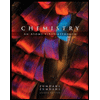 Chemistry: An Atoms First ApproachChemistryISBN:9781305079243Author:Steven S. Zumdahl, Susan A. ZumdahlPublisher:Cengage Learning
Chemistry: An Atoms First ApproachChemistryISBN:9781305079243Author:Steven S. Zumdahl, Susan A. ZumdahlPublisher:Cengage Learning
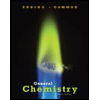 General Chemistry - Standalone book (MindTap Cour...ChemistryISBN:9781305580343Author:Steven D. Gammon, Ebbing, Darrell Ebbing, Steven D., Darrell; Gammon, Darrell Ebbing; Steven D. Gammon, Darrell D.; Gammon, Ebbing; Steven D. Gammon; DarrellPublisher:Cengage Learning
General Chemistry - Standalone book (MindTap Cour...ChemistryISBN:9781305580343Author:Steven D. Gammon, Ebbing, Darrell Ebbing, Steven D., Darrell; Gammon, Darrell Ebbing; Steven D. Gammon, Darrell D.; Gammon, Ebbing; Steven D. Gammon; DarrellPublisher:Cengage Learning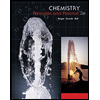 Chemistry: Principles and PracticeChemistryISBN:9780534420123Author:Daniel L. Reger, Scott R. Goode, David W. Ball, Edward MercerPublisher:Cengage Learning
Chemistry: Principles and PracticeChemistryISBN:9780534420123Author:Daniel L. Reger, Scott R. Goode, David W. Ball, Edward MercerPublisher:Cengage Learning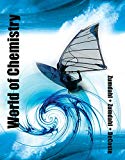 World of Chemistry, 3rd editionChemistryISBN:9781133109655Author:Steven S. Zumdahl, Susan L. Zumdahl, Donald J. DeCostePublisher:Brooks / Cole / Cengage Learning
World of Chemistry, 3rd editionChemistryISBN:9781133109655Author:Steven S. Zumdahl, Susan L. Zumdahl, Donald J. DeCostePublisher:Brooks / Cole / Cengage Learning

Chemistry
Chemistry
ISBN:9781305957404
Author:Steven S. Zumdahl, Susan A. Zumdahl, Donald J. DeCoste
Publisher:Cengage Learning

Chemistry: An Atoms First Approach
Chemistry
ISBN:9781305079243
Author:Steven S. Zumdahl, Susan A. Zumdahl
Publisher:Cengage Learning


General Chemistry - Standalone book (MindTap Cour...
Chemistry
ISBN:9781305580343
Author:Steven D. Gammon, Ebbing, Darrell Ebbing, Steven D., Darrell; Gammon, Darrell Ebbing; Steven D. Gammon, Darrell D.; Gammon, Ebbing; Steven D. Gammon; Darrell
Publisher:Cengage Learning

Chemistry: Principles and Practice
Chemistry
ISBN:9780534420123
Author:Daniel L. Reger, Scott R. Goode, David W. Ball, Edward Mercer
Publisher:Cengage Learning

World of Chemistry, 3rd edition
Chemistry
ISBN:9781133109655
Author:Steven S. Zumdahl, Susan L. Zumdahl, Donald J. DeCoste
Publisher:Brooks / Cole / Cengage Learning
Unit Cell Chemistry Simple Cubic, Body Centered Cubic, Face Centered Cubic Crystal Lattice Structu; Author: The Organic Chemistry Tutor;https://www.youtube.com/watch?v=HCWwRh5CXYU;License: Standard YouTube License, CC-BY